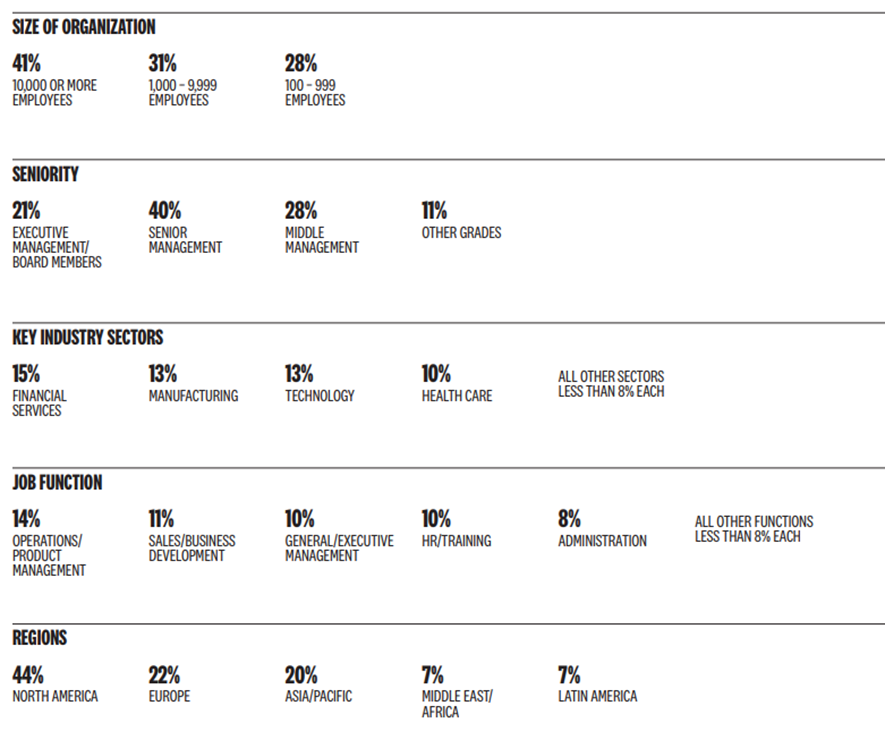What is the message?
Empowering frontline workers with data-driven insights is essential for business success.
Frontline workers, who interact with customers daily, need to be able to make informed decisions in real time.
However, many organizations struggle to provide the necessary resources and tools for this empowerment.
Data-driven decision making is crucial for tailored customer experiences, product development, and operational efficiency.

Adapted from “The new decision makers — equipping frontline workers for success”, published by Harvard Business Review, written by Sudheesh Nair — Thoughtspot CEO
Key points
· 87% of survey respondents say their organization will be more successful when frontline workers are empowered to make important decisions in the moment.
· 86% say frontline workers need better technology-enabled decisions in the moment.
· 72% insight to be able to make good say productivity has increased through empowering frontline workers.
Respondents who have started down that road are already reaping the benefits, with
· 72% saying productivity has increased at least moderately by empowering frontline workers,
· 69% saying they’ve increased both customer and employee engagement/ satisfaction, and
· 67% saying they’ve increased the quality of their products/ services.

DEEP DIVE
THE NEW DECISION MAKERS
Equipping Frontline Workers with data for Decision Making
Harvard Business Review
2020
Introduction
Customers determine the success of every business. In any organization, the only group that interacts with customers on a daily basis is the front line. It’s truly where the rubber meets the road. Smart organizations know they need to empower these frontline workers with the ability to make informed decisions in the moment. The reality is that few organizations are able to deliver on this, because until recently, there has been a dearth of resources required to empower knowledge workers to be more autonomous.
Data-driven insights are critical to all business activities, whether it’s delivering a tailored customer experience, bringing a new product to market, or streamlining operations. When the data exists but a company lacks the tools or culture to enable employees to effectively access and analyze it, businesses miss out on opportunities, employees wind up frustrated, and customers suffer. Enterprises must leverage their most valuable asset for decision making — they owe it to themselves and to their workforce.
ThoughtSpot sponsored this report by Harvard Business Review Analytic Services to give leaders an understanding of why they must not only empower their workforces and equip them with the tools they need to make informed business decisions but also provide a blueprint for how to do so. Hundreds of business executives weighed in on their approach to creating a data-driven environment — or not — and the impact it’s having on their business.
If you’re a business leader and find you’re constantly confronted with the directive to be more data-driven, it can be scary. But you’re certainly not alone. You need clarity around why and how to make this change. Fortunately, the data provided in this report shows exactly how the “leaders” (those organizations whose frontline workers are both empowered and digitally well equipped) are able to maintain their front-runner positions and the corresponding business benefits compared to their “laggard” peers (those whose employees are neither empowered nor well equipped).
Data can uncover truths we didn’t even know to look for. In this report, we see how organizations that are moving toward a more distributed and autonomous way of working are getting ahead, while those that deprioritize data-based decision making for frontline workers are failing to realize the same rates of productivity and customer satisfaction, among other metrics.
While what needs to happen for optimal business success is clear, it’s not necessarily an easy shift to make. For some organizations, it means overhauling entire frameworks and hierarchies to accommodate a new way of doing business. But I hope you will take inspiration from this report, learn from those on the front lines of this data-driven culture shift, and recognize the long-term dividends this adoption will deliver.
SUDHEESH NAIR
THOUGHTSPOT, CEO
Overview
Organizations across industries are under pressure to operate more quickly and with greater intelligence than ever before. Armed with new digital tools that enhance the capabilities of frontline workers, companies in the manufacturing, technology, financial services, energy, and health care sectors, among others, are extending their digital reach to the edges of their business and beyond. Becoming more data-driven “has changed dramatically the work and types of people who can do the work,” says Kerry Small, who leads global commercial and operations for Vodafone Business. For Small, that includes commercial and sales teams, delivery teams, and customer service professionals. “It’s absolutely transformational for the world of work,” she says.
The challenge now is to empower frontline workers in a way that creates both free agency for them and proper controls for the organization. What makes this possible is the ready availability of high-quality information and insights at the point of contact with customers and operations, along with the digital tools and procedures to ensure compliance with company guidelines and industry regulations. But we’re still in early days.
Eighty-seven percent of the 464 business executives responding to a recent global survey from Harvard Business Review Analytic Services say their organization will be more successful when frontline workers are empowered to make important decisions in the moment. Until recently, however, even companies that wanted to empower their frontline employees to work more autonomously haven’t had the necessary data and tools to make that happen. Eighty-six percent of respondents say that frontline workers need better technology-enabled insight to be able to make good decisions in the moment.
Only one-fifth of organizations in the survey have frontline workers who are both empowered and digitally well equipped to succeed in this way. These are the leaders. Thirty-seven percent are followers, with workers who are somewhat empowered and digitally equipped, and 43% are laggards — neither empowered nor well equipped.
Highlights
· 87% of survey respondents say their organization will be more successful when frontline workers are empowered to make important decisions in the moment.
· 86% say frontline workers need better technology-enabled decisions in the moment.
· 72% insight to be able to make good say productivity has increased through empowering frontline workers.
FRONTLINE WORKERS: Employees who are the first point of contact between organizations and their customers or who work in a company’s product or service operations. These include salesclerks, nurses, flight attendants, maintenance workers, electricians, store managers, service technicians, field salespeople, and more.
Leaders are substantially more likely to have benefited from the investments they have made in their frontline workforce, with at least one-third of respondents claiming significant increases in both customer and employee engagement and satisfaction and in the quality of their products and services. FIGURE 1 They’re also much more likely than other respondents to report significant gains in productivity, innovation, top-line growth, market position, and profitability from these efforts.
FIGURE 1
FRONTLINE EMPOWERMENT BOOSTS BUSINESS RESULTS
Leaders find this to be especially true with customer engagement
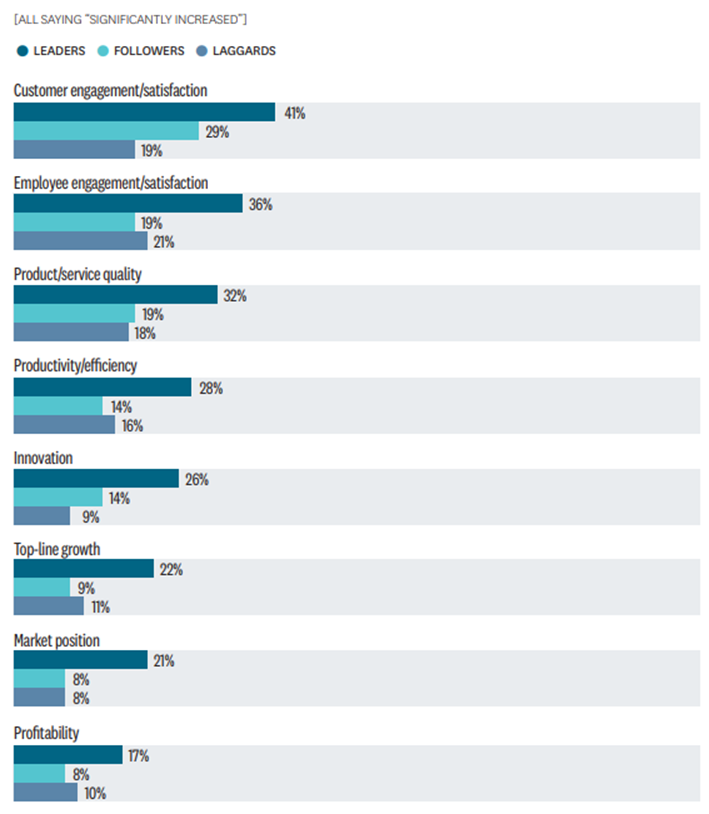
SOURCE: HARVARD BUSINESS REVIEW ANALYTIC SERVICES SURVEY, JANUARY 2020
Respondents across the board strongly believe that both work quality and productivity will increase as more data-based insights are made available to frontline workers.
Ninety-two percent say the quality of work of frontline employees in their organization would improve in the long term, and 73% say it would improve in the short term as well.
While most respondents (81%) also anticipate some gains in productivity in the short term, only 27% expect the short-term gains to be significant.
However, that figure nearly triples to 74% for the long term. FIGURE 2
FIGURE 2
PRODUCTIVITY INCREASES SIGNIFICANTLY OVER TIME
Respondents see some short-term gains and dramatic increases over the long term
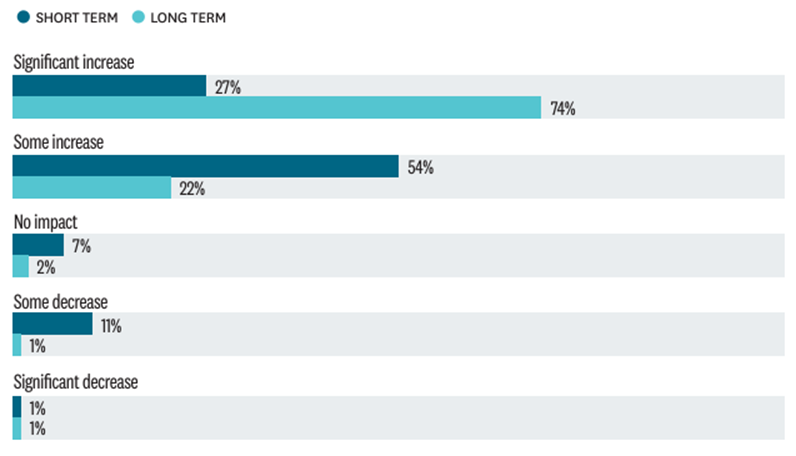
SOURCE: HARVARD BUSINESS REVIEW ANALYTIC SERVICES SURVEY, JANUARY 2020
That increase won’t just happen by itself. There are some key steps organizations must take to get there, according to survey findings and interviews with a dozen senior business and analytics leaders.
In addition to equipping employees with new digital tools and information, frontline champions need to enlist company leaders to drive culture change. Training and change programs must engage all parts of the organization, from leaders to middle managers to the frontline workers themselves. “Frontline employees have a better understanding of how the business works,” says a senior strategist at a large investment company about its change efforts. “It’s leveling the playing field between leadership and frontline workers.” This is a massive change for everyone.
Many companies will have to redesign or override existing organizational structures to accommodate new lean, cross-functional ways of working. And as they push data, insight, and decision-making ability out to frontline workers, organizations will need to make sure that data security and governance practices keep up with the new reality.
The Two-Sided Coin: Empowerment and Enablement
There are two critical aspects of creating an empowered and data-driven enterprise.
The first involves a culture shift. Leaders are more than twice as likely as laggards (51% versus 23%) to say a data-driven culture is a critical part of their organization’s corporate strategy.
For data-driven decision making to become ingrained in the culture requires moving from a hierarchical to a more distributed way of working — many refer to this as the democratization of data. Frontline employees must be empowered at the point of need.
The other side of the coin requires equipping employees with the right data, insight, and technology to enable faster, more distributed, and higher-quality decision making. “Data is powerful when it is in everyone’s hands,” says Vodafone’s Small.
Leaders are more than twice as likely as laggards (58% versus 24%) to strongly assert that their company is increasing its investment in digital capabilities to transform the frontline workforce, their technology, and their environment.
“It all starts with the data,” says Small. “If you don’t have the right structures in the beginning, it’s going to be difficult.” Vodafone made a large investment up front in data dictionaries, data hierarchies, and having a single record for everything. That investment, she says, was “the right thing to do.”
Compelling Benefits
Respondents have high expectations for the business benefits of investing in analytics for the front line.
They believe it will increase customer engagement and satisfaction (named by 65%), productivity and efficiency (62%), employee engagement and satisfaction (49%), and product/service quality (45%). These findings underscore the importance of equipping the front line for success.
Respondents who have started down that road are already reaping the benefits, with
· 72% saying productivity has increased at least moderately by empowering frontline workers,
· 69% saying they’ve increased both customer and employee engagement/ satisfaction, and
· 67% saying they’ve increased the quality of their products/ services.
GE Healthcare in Brazil has seen an increase in both patient satisfaction and profitability (by reducing the number of service visits required, along with variable costs to service clients).
Top-line revenue has also increased, and with reduced equipment downtime, they’ve seen a direct correlation between customer satisfaction, increased sales, and market share.
Vodafone’s Small is expansive about the business benefits of increased empowerment. “We’re a service business,” she says. “How we deliver is paramount. Our people are the face of the organization.”
According to Small, engagement levels have increased tenfold among the employees who have been part of the company’s transformation efforts to date. This engagement boost has resulted in greater commitment to the business, discretionary effort, and accountability as well.
Different Degrees of Empowerment
Not all organizations view empowerment in the same way. At the most basic level, it simply means getting the right information to frontline workers in a form they can use when they need it. For instance, at the operations of a global equipment manufacturing and service company in Hungary, employees repair a variety of devices like laptops. They need specific information about the unit they’re working on and what to do about it. “The need for real-time information is critical,” says a business unit director there. “Every unit is an individual case.”
Knowing right away what is wrong with a unit and what to test before starting a repair improves quality and saves time. It also makes reporting to customers more efficient, enabling some program managers to handle two programs instead of one.
In this example, frontline workers’ jobs aren’t changing significantly, but they are working more efficiently and effectively because they have access to better information faster.
Such systems apply in fieldwork as well. In the United States, the public works department in Fairfax, Va., is equipping operations and maintenance workers with handheld devices that provide field access to infrastructure data. In the future, this will include the history of an asset (the machinery in a pump station, for instance) and its prior maintenance and problem profile, says Juan Reyes, the department’s assistant director.
The old manual approach is inadequate for increasingly sophisticated civil infrastructure equipment and controls. With the new asset management system, technicians will be able to pull up the manufacturer’s schematics for all components, review recommended maintenance intervals, access repair manuals, and more.
At the same time, the system will manage the workflow and what actions are required by the municipality. Actions taken and repairs made will be captured in the system from the field as well. As a result, technicians will be able to service more equipment more effectively. “The system turns data into information and knowledge,” says Reyes. “It’s more than just empowering; it’s adding to their capacity.”
GE Healthcare in Brazil takes this capacity expansion up a level, using sensors and artificial intelligence (AI) for predictive maintenance on its medical equipment installed in hospitals and clinics, according to Luis Paulo Souza, principal.
Much of the diagnostics happen in the background. When an engineer goes to a site to make a repair, he or she already knows what the problem is and has been provided with insight about how to fix it.
An AI-enabled workflow will refer a specialist to assist the technician if necessary.
For the sales workforce, robotic process automation is being put in place to streamline commercial processes and approvals.
Simplifying Complexity and Enabling Autonomy
As processes and the data that underlie them become more sophisticated, organizations must ensure they don’t create unmanageable complexity.
Empowering frontline workers often “requires more complex consumption of information,” says the vice president of IT enterprise architecture at a global automotive supplier. “We need to provide information to workers digitally on the spot in a way that it is easy to consume.”
This is a challenge with a large hourly workforce. The company uses analytics to “optimize the gap between how we think people should work and how they really work,” he says. And the company is using AI to automate and optimize more of its processes.
At the most empowered organizations, frontline employees are not just able to take action based on data, and insight provided to them; they’re encouraged to go beyond the scope of what their jobs encompassed in the past to operate more autonomously.
The large investment firm is using new digital capabilities to eliminate bottlenecks at the point of contact with customers. Armed with the right information, frontline workers can resolve more issues on the spot without the intervention of a supervisor.
They also have become a critical part of getting the voice of the client back to the manager team and R&D as quickly as possible. “We’re now able to pivot and make changes where necessary,” says the senior strategist, rather than waiting for limited customer surveys to be sorted. “As the world changes, we need more analytic problem solvers,” she says.
To take on this new role, frontline employees may be required to think about the business in a new, more expansive way — more like managers than foot soldiers. For example, when an issue crops up, managers will consider how many clients it will affect and whether the issue should be prioritized over other things. “We want to get that same kind of decision making into the heads of our frontline employees,” she says.
Training and Development: New Tools Are Just the Beginning
Frontline employees have become the new user base for digital tools. Communication and collaboration tools and self-service analytics top the list of technologies that survey respondents expect frontline workers to be using over the next two years, with both named by more than 50%. FIGURE 3
FIGURE 3
DIGITALLY ENABLING THE FRONT LINES
Technologies respondents expect frontline workers to be using over the next two years
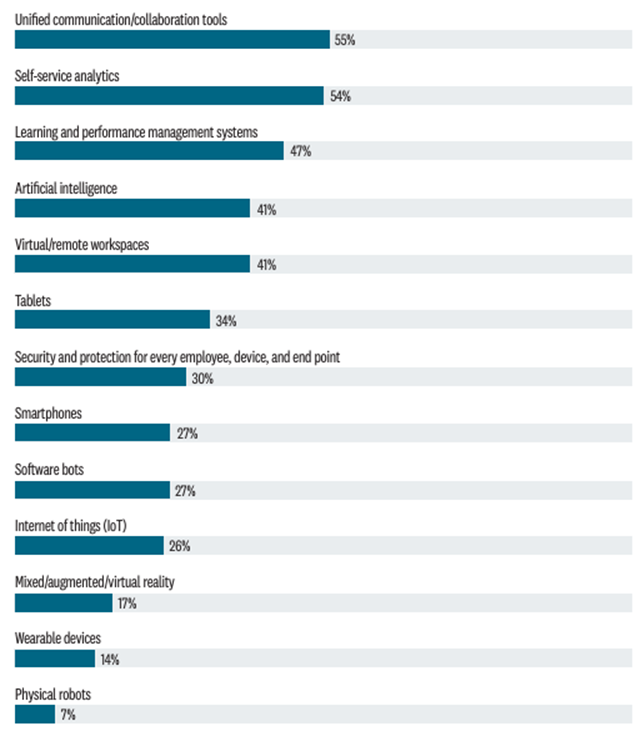
SOURCE: HARVARD BUSINESS REVIEW ANALYTIC SERVICES SURVEY, JANUARY 2020
Much of this technology will be new for frontline workers. Given the nature of the work and the workforce — especially when it comes to hourly workers, where there is likely to be higher turnover — it is imperative that frontline tools be as accessible and intuitive as possible and that training be built into the process.
The good news is that 68% of respondents say their organization invests in training and development programs to teach frontline workers how to use innovative technology tools.
However, knowing how to use the tools is just the first step. Frontline workers also need to know how to effectively apply the technology-enabled insight the tools generate.
A smaller percentage (46%) are teaching this capability to their frontline workers. FIGURE 4
FIGURE 4
TRAINING FOR APPLYING INSIGHTS NOT KEEPING PACE
Respondents more likely to prepare for using tools than data-based decision making
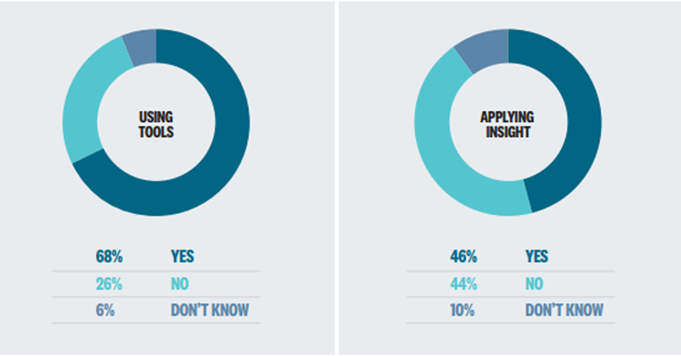
SOURCE: HARVARD BUSINESS REVIEW ANALYTIC SERVICES SURVEY, JANUARY 2020
The ability of workers to apply insight is an area that needs attention. Nearly a third of respondents (31%) cited frontline employees’ lack of skills to make appropriate use of technology-enabled insight as a top-three barrier to their ability to make good decisions in the moment.
The only barrier that rated higher in importance was a lack of effective change management and adoption processes. FIGURE 5
FIGURE 5
LACK OF CHANGE MANAGEMENT IS TOP BARRIER
Percentage of respondents who named these obstacles among their top three
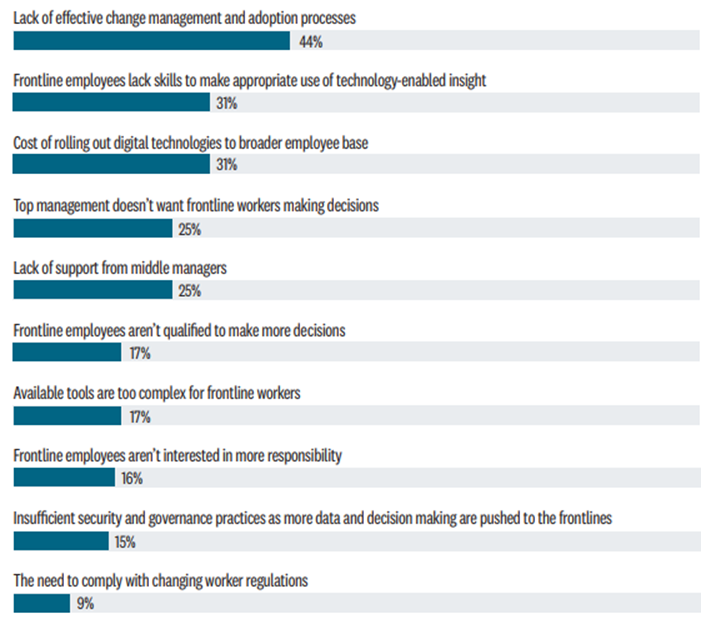
SOURCE: HARVARD BUSINESS REVIEW ANALYTIC SERVICES SURVEY, JANUARY 2020
At multinational telecom company Ericsson, “we’re really focused on helping frontline employees work in a world that is data-driven and more automated,” says Drew Abbey, people business partner for Supply Americas at Ericsson. “Training to define how to use the tools is secondary.”
German loyalty program provider Payback devotes 20% of its training to how to use the tool and 80% to using the data, according to Andreas Kretschmer, director of analytics. This involves one-to-one peer coaching in how to get the most from the insight.
The “trainers” are people who have cycled through the analytics function, have received more intensive training, and are very knowledgeable about the data. These people team up with account managers and show them what information to look for and how to get it through the tool.
One of the challenges with training for a large user base is how to scale the learning. In addition to a “train the trainer” program for analytics, Verizon provides field managers with a social platform to ask questions, according to Ansar Kassim, consumer analytics leader. If a particular question has already received an answer, that answer pops up. If not, anyone from the community can respond. Kassim’s team watches the forum, and if a question isn’t getting answered by the community, one of them will step in.
Leader organizations also build instruction into the tool or process itself. The global automotive supply company provides on-the-spot microtraining delivered digitally at the time and place it is needed. This is in addition to up-front training for new manufacturing methods and procedures, as it combines all its shopf loor systems “into one streamlined user experience,” says the vice president of IT enterprise architecture.
Shifting to a Data-Driven Culture
While training frontline workers in the skills needed to operate more effectively is a good start, it’s not enough in itself. The shift to a data-driven culture and way of working goes beyond learning specific skills.
The Fairfax public works department is changing work processes that are decades old. “That’s culture change,” says the department’s Reyes. Engaging frontline staff up front to get their input and demonstrating how the new process helps them do their jobs better are both essential to help people over that hurdle. Ongoing training reinforces the change.
Ericsson is building a culture in which “people are empowered to make decisions based on facts and good information,” says Abbey. Making “courageous, fact-based decisions” is one of five key focus areas of the company’s current transformation.
The others relate directly to empowerment, including cooperation and collaboration; speaking up, with everyone having a voice; empathy; and a willingness to execute quickly.
The transformation effort began with engaging all 7,500 of the company’s top leaders over an 18-month period. These principles are now being activated through the rest of the 100,000-person organization, with leaders encouraging their teams to think differently and providing recognition for people who demonstrate the new behaviors.
Some see the shift to a data-driven culture as an even more fundamental challenge — the fact that a lot of people simply don’t like numbers or math — which can be a problem in statistics-driven industries like insurance. “Outside some core areas such as actuarial and underwriting, a lack of data literacy is the single largest enemy we are fighting,” says Bill Zhang, chief data and analytics officer at insurer AIG Japan. “As the world becomes increasingly driven by data, it’s an even bigger challenge. Everyone has to understand the basics, and we have to be able to convey that in a way that is intuitive and fun.”
To that end, the company uses quizzes and daily life scenarios that are not necessarily work-related but that allow employees to easily connect and grasp the relevant concepts.
AIG Japan uses data influencers — people who are deeply passionate about data — to serve as champions throughout the business. After going through a training camp with the analytics group, these people go out into the business to run operations or work on the front line, where they can influence others in their peer group.
Rigid organizational design can stall the process, says Small. Where traditional hierarchies are siloed, “agile breaks that model completely,” she says. “It takes people time to realize they have been empowered to work outside their function.”
Five Steps to Empower Your Frontline Workforce
Leaders point to five key enablers of a productively empowered front line:
1. Leadership
Top management must buy into and demonstrate support for frontline empowerment, given the organizational change required.
2. Data
A data-driven culture must be a critical part of the corporate strategy.
3. Governance
Security and governance must be built into new processes to provide frontline workers with both autonomy and controls.
4. Training
Training should be a priority — not just to teach workers how to use new technology tools but also to show them how to effectively apply the insights that this technology provides.
5. Facilitators
Frontline managers and supervisors are key contributors and also need new tools and training to empower frontline employees.
At Vodafone, data champions hold webinars, teach groups of employees, share success stories, and help build confidence throughout the organization.
The importance of change management programs at all levels of the organization cannot be overstated. Survey respondents named the lack of such programs the greatest barrier to empowering frontline workers, with 44% choosing it as a top-three barrier.
But only 38% of respondents say their organizations have change programs in place to facilitate a shift to a more self-sufficient workforce. Leaders are doing more, at 63%.
Frontline Engagement Transforms Organizations
Becoming more data-driven often requires changing existing processes and even organizational structures and roles. This shift affects both frontline employees and the analytics team as they shift from being report generators to serving as coaches and facilitators.
Now when the Payback analytics team gets requests to answer questions, they instead show account managers in the business units how to get the answer for themselves. Now they can spend more of their own time on higher-level problems.
Verizon’s analytics team used to generate around 600 reports daily. They eliminated these reports last year, and the team trained people how to get the information they were looking for by themselves. If someone still needs a report, they are taught how to create it.
By enabling employees to directly access the data they need, Verizon is creating scale and deepening the intelligence of the organization overall. “In the past, we could answer a few hundred questions a month,” says Verizon’s Kassim. “Now around 2,000 questions are answered every month. What used to take two days or sometimes two weeks can now happen in a few hours.”
At Vodafone, half the legacy job titles in commercial teams have changed to the point where they are now “unrecognizable,” as people have been given more autonomy for such things as making pricing decisions, says Small. “In some cases, it’s changing entire structures, creating a new organization at the end.”
New methods entail crossing silos and blurring lines. For instance, to better accommodate customer requests, GE Healthcare in Brazil is combining traditional roles of operations and customer satisfaction, providing those employees with information about installation, operation, and satisfaction. This data makes workers more intelligent, improving patient experience and increasing uptime.
Rigid organizational design can stall the process, says Small. Where traditional hierarchies are siloed, “agile breaks that model completely,” she says. “It takes people time to realize they have been empowered to work outside their function.”
Both GE Healthcare Brazil and the large investment firm use a lean management approach to ensure that the strategic goals of the company translate into action at every level. Vodafone and others are engaging frontline employees in the design process, using design thinking and agile methods to identify the business problem and the outcome they want to achieve, creating wireframe designs, and taking the lead on user testing. “They are 100% involved and accountable,” says Small. The groups review lessons learned at the end of each 12-week sprint and discuss how to make things better next time.
Creating Accountability through Change
With so much changing, organizations need to make sure their data security and governance practices keep up. There may be new exposure from a technical perspective as more devices and data are distributed throughout the organization.
And policies about and controls over who has access to what information and who has decision rights will have to be revised and updated.
Less than half of followers and laggards (47% and 48%, respectively) say they have sufficient security and governance practices as more autonomy is introduced into the frontline workforce.
Leaders are much better positioned, with 75% saying they have enough security and governance.
The Fairfax public works department sets parameters for the type of work field crews can carry out without requiring a supervisor’s approval and periodically reviews these as capabilities are enhanced. “If a job is extensive and requires going above a certain limit, that’s going to require some vetting,” says Reyes. Within those parameters, however, crews have more flexibility than in the past.
Armed with much more detailed customer and product information, Vodafone’s commercial and sales teams have greater latitude to make pricing decisions in the field. But built-in controls delineate “floors and ceilings” within which they can operate.
Laggards Have a Leadership Problem
Of course, empowering and equipping frontline workers won’t happen without commitment and leadership from the top of the organization, and this is one area where there are stark differences between leaders, followers, and laggards.
Respondents from leader organizations are more than three times as likely as laggards to strongly agree with the statement “My company’s leaders (CEO, line of business leaders, etc.) promote a more digitally connected and empowered frontline workforce,” at 53% versus 16%. Followers fell somewhere in between, at 36%.
One reason for the discrepancy is that executives at laggard companies simply don’t believe in the value of having their frontline workers make decisions. Respondents at laggard companies are 10 times as likely as leader respondents to say their top management doesn’t want frontline workers making decisions (42% versus 4%). FIGURE 6
FIGURE 6
LAGGARDS DON’T SHARE DECISION MAKING
They are ten times more likely to refuse to let frontline workers make decisions
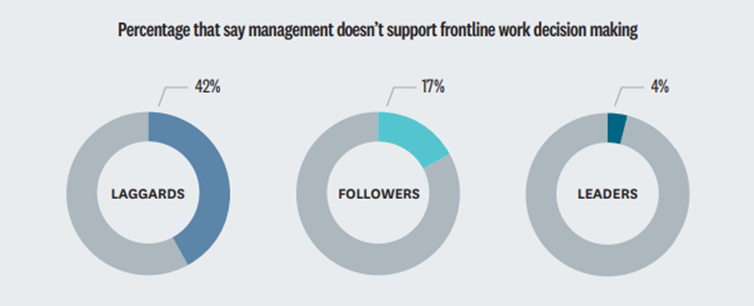
SOURCE: HARVARD BUSINESS REVIEW ANALYTIC SERVICES SURVEY, JANUARY 2020
Analytics proponents can help by engaging company leaders from the start. For instance, Payback involved board members and executives before making the investment in new analytics capabilities. “We said, ‘We’re going to invest in this tool, but if we don’t have your support, it won’t work’”, Kretschmer, the company’s analytics director, says. “We had to convince them of the benefits from the start.”
ANALYTICS PROPONENTS CAN HELP BY ENGAGING COMPANY LEADERS FROM THE START
· 91% of respondents say that managers and supervisors play an essential role in empowering frontline workers.
· 50% say managers and supervisors are not well equipped to empower frontline employees appropriately.
Those that recognize the extent of the change required are making a commitment that starts at the top and extends throughout the entire organization.
Changes at the investment company have gone well beyond the use of new tools, says the senior strategist, requiring “mindset changes among top officers, and shifting deeply held behaviors — from command and control to servant leadership.” This transformation included a more data-driven, inclusive, test-and-learn approach to problem solving rather than leaders having all the answers.
With senior leaders on board, it becomes much easier to engage the middle part of the organization — in particular, frontline managers. Nearly all respondents (91%) say that managers and supervisors play an essential role in empowering frontline workers, yet half (51%) say managers and supervisors are not well equipped (with the right tools, training, and knowledge) to empower frontline employees appropriately.
The senior strategist at the investment firm refers to this as the frozen middle. “These are people who have been successful with certain behaviors in the past. Now we’re asking them to try different behaviors. Habits are hard to change.”
But change they must. A quarter of respondents say that a lack of support from middle managers is a top-three barrier to empowering frontline employees.
Payback got traction with its frontline managers by getting them engaged. “What convinced them most was showing them how to answer their day-to-day business questions in the tool,” says Kretschmer. “When they saw what they would get out of it and that it would simplify their job, then it became easy.”
Conclusion
There is wide-scale agreement across industries that empowering frontline workers with information and insight is key to future success. For the IT enterprise architect at the global automotive supplier, empowerment is the “easy consumption of data in daily life.” While reports still may have their place, they are static. Becoming data-driven means being able to “ask questions and get answers in a dynamic way with an easy user experience,” he says.
Organizations that want to empower their frontline employees to work more autonomously now have the means to do so. But transformation requires more than just adopting new digital tools. Those that recognize the extent of the change required are making a commitment that starts at the top and extends throughout the entire organization. In the process, they are increasing the engagement and effectiveness of their frontline workers and improving their most important business metrics — from productivity to customer and employee satisfaction to the bottom line.
Frontline leaders will learn and evolve as they go. “As we become more versed in how data drives decision making,” says Ericsson’s Abbey, “we will see new and novel ways to make decisions and define new ways of working.”
METHODOLOGY AND PARTICIPANT PROFILE
A total of 464 respondents drawn from the HBR audience of readers (magazine/ enewsletter readers, customers, HBR.org users) completed the survey.
